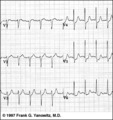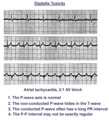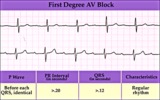The Health Education Assets Library (HEAL) is a collection of over 22,000 freely available digital materials for health sciences education. The collection is now housed at the University of Utah J. Willard Marriott Digital Library.
TO
| Title | Description | Subject | Collection | ||
|---|---|---|---|---|---|
| 51 |
 |
ST segment depression: precordial leads | ST segment depression: precordial leads | Knowledge Weavers ECG | |
| 52 |
 |
Idioventricular escape rhythm | Idioventricular escape rhythm | Knowledge Weavers ECG | |
| 53 |
 |
Initiation of beta-oxidation | An acetyl group is transferred from acetyl CoA to the -SH group of the condensing enzyme domain of fatty acyl synthase, forming acetyl-CE. The reaction is catalyzed by the acyltransferase activity of fatty acyl synthase. | Knowledge Weavers Fatty Acids | |
| 54 |
 |
Unifocal PVCs - marquette | Unifocal PVCs - marquette | Knowledge Weavers ECG | |
| 55 |
 |
Two Wrongs Sometimes Make a Right | The question mark is over a normal looking QRS that occurs during 2:1 AV block with RBBB. Following this QRS a ventricular escape rhythm takes over. The normal looking beat is actually a fusion beat resulting from simultaneous activation of the ventricles; the sinus impulse enters the left ventric... | Knowledge Weavers ECG | |
| 56 |
 |
WPW type preexcitation | Note the short PR and the subtle delta wave at the beginning of the QRS complexes. The delta wave represents early activation of the ventricles in the region where the AV bypass tract inserts. The rest of the QRS is derived from the normal activation sequence using the bundle branches. | Knowledge Weavers ECG | |
| 57 |
 |
Long QT interval | The QT interval duration is greater than 50% of the RR interval, a good indication that it is prolonged in this patient. Although there are many causes for the long QT, patients with this are at risk for malignant ventricular arrhythmias, syncope, and sudden death. | Knowledge Weavers ECG | |
| 58 |
 |
Wandering atrial pacemaker | Wandering atrial pacemaker is a benign rhythm change where the pacemaker site shifts from the sinus node into the atrial tissues. P-wave morphology varies with the pacemaker site. | Knowledge Weavers ECG | |
| 59 |
 |
QRS axis = +60 degrees | Lead aVL is isoelectric; leads II and III are mostly positive. The QRS axis, therefore, is +60 degrees. | Knowledge Weavers ECG | |
| 60 |
 |
Electronic ventricular pacemaker rhythm - marquette | Electronic ventricular pacemaker rhythm - marquette | Knowledge Weavers ECG | |
| 61 |
 |
High lateral wall MI (seen in aVL) | High lateral wall MI (seen in aVL) | Knowledge Weavers ECG | |
| 62 |
 |
Atrial tachycardia - marquette | Atrial tachycardia - marquette | Knowledge Weavers ECG | |
| 63 |
 |
LVH with Strain | LVH with Strain | Knowledge Weavers ECG | |
| 64 |
 |
PAC's with RBBB aberrant conduction | PAC's are identified by the arrows. Note that the PP interval surrounding the PAC is less than 2x the basic sinus cycle indicating that the sinus node has been reset by the ectopic P wave. The pause after the PAC, therefore, is incomplete. | Knowledge Weavers ECG | |
| 65 |
 |
1st degree AV block | The normal PR interval is 0.12 - 0.20 sec, or 120 -to- 200 ms. 1st degree AV block is defined by PR intervals greater than 200 ms. This may be caused by drugs, such as digoxin; excessive vagal tone; ischemia; or intrinsic disease in the AV junction or bundle branch system. | Knowledge Weavers ECG | |
| 66 |
 |
Sore thumbs | Two funny looking premature beats are seen in this rhythm strip. Beat A is preceded by a PAC which distorts the T wave, making this an aberrantly conducted PAC. Beat B is a PVC. The notch on the down slope of the QRS complex clearly identifies this as a PVC and not aberrancy. | Knowledge Weavers ECG | |
| 67 |
 |
AV dissociation by default | If the sinus node slows too much a junctional escape pacemaker may take over as indicated by arrows. AV dissociation is incomplete, since the sinus node speeds up and recaptures the entricles. | Knowledge Weavers ECG | |
| 68 |
 |
Fatty acid metabolism -- schematic overview | Fatty acids are taken up by cells, where thy may serve as precursors in the synthesis of other compounds, as fuels for energy production, and as substrates for ketone body synthesis. Ketones bodies may then be exported to other tissues, where they can be used for energy production. | Biosynthesis | Knowledge Weavers Fatty Acids |
| 69 |
 |
Atrial tachycardia with 2:1 AV block: a manifestation of digitalis intoxication | Atrial tachycardia with 2:1 AV block: a manifestation of digitalis intoxication | Knowledge Weavers ECG | |
| 70 |
 |
Condensation of an acyl group with a malonyl group | The acetyl group displaces the carboxyl of the malonyl group, forming a beta-ketoacyl group. This reaction is catalyzed by beta-ketoacyl Acyl Carrier Peptide synthase. The carboxyl released in the form of bicarbonate regenerates the bicarbonate used earlier in the acetyl CoA carboxylase reaction. | Knowledge Weavers Fatty Acids | |
| 71 |
 |
Accelerated junctional rhythm - marquette | Accelerated junctional rhythm - marquette | Knowledge Weavers ECG | |
| 72 |
 |
First degree AV block - marquette | First degree AV block - marquette | Knowledge Weavers ECG | |
| 73 |
 |
AV sequential pacemaker - marquette | (Summary) | Knowledge Weavers ECG | |
| 74 |
 |
Essential features of a fatty acid | The essential features of a fatty acid are a long hydrocarbon chain terminating in a carboxylic acid group. | Knowledge Weavers Fatty Acids | |
| 75 |
 |
Postero-lateral MI: Fully Evolved | The true posterior MI is recognized by pathologic R waves in leads V1-2. These are the posterior equivalent of pathologic Q waves (seen from the perspective of the anterior leads). Tall T waves in these same leads are the posterior equivalent of inverted T waves in this fully evolved MI. The loss o... | Knowledge Weavers ECG |
